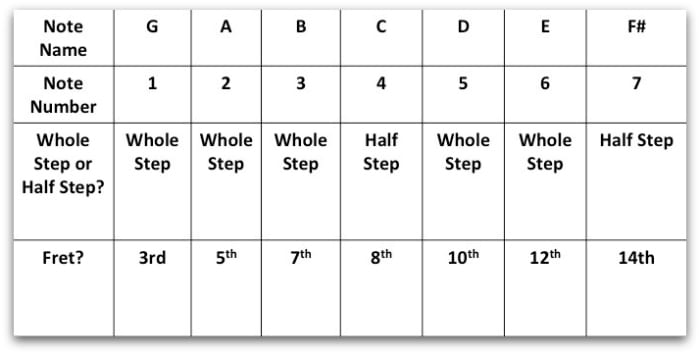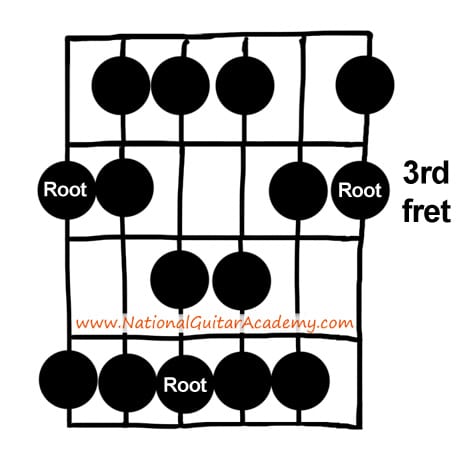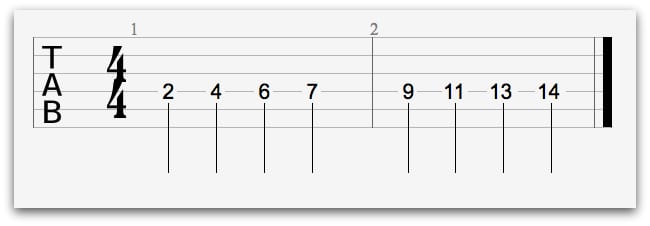Wondering how to play the major scale? Then this lesson is for you, we’re going to show you everything you need to know about the major scale.
In this free guitar lesson, you will learn:
- 3 super-easy major scale patterns.
- 2 essential tips which help your scales sound amazing!
- 3 must-know theory hacks which will take your playing to the next level.
- The secrets of the major scale pattern.
Over 100,000 guitar-learners get our world-class guitar tips & tutorials sent straight to their inbox: Click here to join them
Learning Major Scale Guitar Patterns – Pattern 1
The major scale is one of the most important scales you can learn on guitar.
We’re going to show you how to play the major scale. For this example, we’re going to learn this scale in the key of G.
This means that our starting note is the 3rd fret of the low E string. (6th string.)
Here’s the tab:
(If you don't understand the above image please read our article "How To Read Guitar Chordboxes In 60 Seconds". It will make everything clear!)
Here’s what it sounds like:
This is one of the most common major scale patterns, make sure you spend a bit of time getting to grips with this essential scale.
Scale Practice Tips
Learning scales are a great way of improving your skills as a guitar player. Here are some essential tips that you can use to accelerate your progress.
Want free guitar lessons? Go here: Learn Guitar Online: Beginner, Intermediate & Advanced Lesson Programmes
Major Scale Guitar Tip #1 Go Slow!
This is arguably one of the most important tips you can have when learning guitar scales. It’s SO important that you play your scales slowly.
Going slow helps you learn guitar scales quicker.
Think of it like this, have you ever been late for work or school?
When you’re late for work or school, you often rush around the house trying to get ready, often this makes you forget important things and makes you less productive.
Compare this to the feeling you have when you have plenty of time to get ready in the mornings. Which one is less stressful?
Of course, you are more productive when you give yourself more time to get ready in the morning.
Let’s compare this to learning scales. Playing scales quickly is the equivalent of being late for work. When you learn scales quickly, you often forget notes and can never remember the scale.
If you practice the scale slowly, you can learn the scale far quicker than if you practised fast. Take the time to practice your scales slowly, you’ll thank yourself later. 🙂
Major Scale Guitar Tip #2 Use Your Fingertips
When you play guitar scales, don’t use the fleshy parts of your fingers.
Make sure that you:
- Use your fingertips.
This helps each note to have clarity and definition.
For more scale tips, go here: Learn Guitar Scales In 8 Easy Steps
Major Scale Guitar Tip #3 Start And Finish With Your Root Note
Every time you practice a guitar scale, start and end with your root note.
By starting on the root note (the first note in the scale) it helps you to hear what the scale sounds like.
This enhances your listening skills and makes you a better guitarist.
To learn more about root notes go here: Guitar Notes Explained: A Guide For Beginners
Moveable Patterns
The best thing about scales is that they are ‘moveable patterns’.
This means that you can move the same pattern to any point on the guitar fretboard. All you have to do is change the starting note.
Try this as a challenge:
- Play the major scale guitar, starting on the 5th fret of the low E string. (6th string.)
Can you hear how this is still a major scale?
When you change the starting note of a scale, you are changing its key.
The 5th fret on the low E string (6th string) is the note ‘A’. Therefore when you play a major scale which starts on the 5th fret, you are playing an ‘A major scale’.
This also works for ANY other note on the low E string. (6th string.)
Here are ALL of the notes on the low E string. (6th string.)

- 3rd fret. (G note.)
- 5th fret. (A note.)
- 7th fret. (B note.)
- 8th fret. (C note.)
- 10th fret. (D note.)
- 12th fret. (E note.)
Notice how the key of the scales changes, when you move it to a different fret.
Download our lead guitar cheat-sheet to make things easier
It's hard to understand which scales work with which keys.
So we created a cheat-sheet! A key and scale-finder that you can use again and again.

Get your personalised guitar-learning plan 🎸
Get a custom guitar-learning plan here: Click here for GuitarMetrics™
World-Class Guitar Courses 🌎
Learn from the world's best guitar educators: Click here for our guitar courses
What Is a Major Scale?
Let’s start with the fundamentals first..What exactly is a scale?
- A scale is a group of notes which work together.
One of the most commonly used scales in music, is the major scale. It forms 90% of all music. So many songs have been written using the major scale.
If you have an understanding of what the major scale is, not only will it aid your guitar playing, it will also ENHANCE your musicality.
Why Do I Need To Know The Major Scales on Guitar?
There are many reasons as to why you need to know the major scale, understanding what scales are advances your guitar playing!
Here are a few core reasons as to why it’s SO important to know the major scale.
1) Learning The Major Scales Enhances Your Solos
One of the most common uses of the major scale is within improvisation.
As the major scale forms 90% of ALL music, it’s essential to know if you want to become a lead guitar master.
To learn more about guitar scales, go here: Learn Guitar Scales In 8 Easy Steps
2) Learning The Major Scale Guitar Improves Your Theory
Learning theory can be incredibly difficult. However; if you can learn the major scale on the guitar, it doesn’t have to be!
Your guitar isn’t just an instrument that you can play music on, it’s also a tool that will help you have a greater understanding of music theory.
3) Learning Major Scales Improves Your Technique
Scales are perfect for drilling guitar techniques. Here are a few techniques you could practice by using guitar scales:
Alternate Picking
Alternate picking is when you pick each note with a downstroke and an upstroke.
Watch this video to learn how to alternate pick:
To learn more about alternate picking, go here: Alternate Picking
Hammer-Ons And Pull-Offs
Hammer’s on and pull off’s are when play a note with your pick, and then hammer your finger onto the next one without picking it.
Watch this video to learn how to play hammer on’s and pull off’s:
One of the best ways to practice this technique is to use guitar scales.
To find out more about these guitar techniques, go here: How To Play Lead Guitar
Fingerpicking
You don’t have to play major scale guitar patterns with your pick, you could also finger pick them!
To learn more about fingerpicking, go here: Fingerstyle Guitar Lessons 5 Easy Ways To Sound Amazing
4) Learning Scales Helps Your Timing
Practising guitar scales helps you develop your timing. One of the best ways to practice scales is to play them to a metronome.
To enhance your timing, try this:
- Set your metronome to 60 bpm.
- For every click of the metronome, play a note of the major scale guitar.
As you get more and more familiar with the scale, experiment with a variety of tempos.
If you haven’t got a metronome, here’s a great FREE resource: METRONOME ONLINE – Free online metronome
Want free guitar tips and video lessons delivered to your inbox?
Join over 100,000 guitar learners and subscribe to our guitar-tips-by-email service. (It's free.)
We'll send you a series of lessons that will move you to the next level of your guitar journey.
Learn how everything fits together quickly, easily and effectively. We share ninja tips (for instant fun!) but also timeless fundamentals that will deepen your understanding.
Our Guitar Courses
To become a better guitarist click here to see our guitar courses
Get your personalised guitar-learning plan 🎸
Want us to make a guitar-learning plan that is customised to you? Click here for GuitarMetrics™
Major Scale Guitar – Understanding Scale Theory
It’s great being able to play the major scale.
However, to really take your guitar playing to the next level, it’s essential that you understand the theory behind it.
We’re going to show you how the major scale is built.
How Is The Major Scale Constructed?
The major scale is built together with a series of steps.
Those steps are:
- Whole step.
- Whole step.
- Half step.
- Whole Step.
- Whole step.
- Whole step.
- Half step.
or W, W, H, W, W, W, H for short.
What Are Whole Steps And Half Steps?
Don’t worry these terms sound far worse than what they are! Let’s break it down.
- A whole step is a 2 fret gap.
- A half step is a 1 fret gap.
The best way to understand this is to apply this theory concept to the guitar.
Try this.
- Play the note G.
You could play this on the 3rd fret of the low E string. (6th string.)
- Now move it up two frets to the 5th fret.
You get to the note A! This is what’s known as a whole step.
Now try this as a challenge..
- Go back to the note G.
- Once you’ve done this, move it up 1 fret to the 4th fret of the low E string. (6th string.)
This is the note ‘G#’. But it is also a half step up from G!
Can you see the difference between a whole step and a half step? Now let’s apply this to the major scale
Major Scale Guitar Construction
When we look at the construction of the major scale, all we have to do is put our whole steps and half steps in order.
That order is W, W, H, W, W, W, H.
To understand this further, let’s apply it to the guitar and try and play a major scale on just one string.
We’re going to show you how to do this in 7 simple steps.
- Find your starting note. For this example, we’re going to start on the 3rd fret of the low E string. (6th string.) This is the note ‘G’.
- Move up a whole step (two frets ) to the 5th fret. This takes you to the note ‘A’. This is the 2nd note in the G major scale.
- Move up a whole step (two frets) to the 7th fret. This takes you to the note ‘B’. This is the 3rd note in the G major scale.
- Move up a half step (one fret) to the 8th fret. This takes you to the note ‘C’. This is the 4th note in the G major scale.
- Move up a whole step (two frets) to the 10th fret. This takes you to the note ‘D’. This is the 5th note in the G major scale.
- Move up a whole step (two frets) to the 12th fret. This takes you to the note ‘E’. This is the 6th note in the G major scale.
- Move up a whole step (two frets) to the 14th fret. This takes you to the note ‘F#’. This is the 7th note in the G major scale.
- Move up a half step (one fret) to the 15th fret. This takes you to the note ‘G’. Congratulations, you’ve completed the octave!
Here’s the theory behind it:

Even though this pattern isn’t the most practical for improvising, it’s great for understanding how the major scale is constructed.
Universal Pattern
The great thing about scale construction , is that it’s the same for ALL major scale keys.
So if you wanted to play a major scale in another key you could use the same method. You just have to change your root note.
Try playing the following scales using the ‘W, W, H, W, W, W, H method.
C Major Scale (Starting On The 3rd Fret On The A String)
Here’s the tab:
E Major Scale (Starting On The 2nd Fret Of The D String)
Here’s the tab:
 F Major Scale (Starting On The 1st Fret On The Low E string)
F Major Scale (Starting On The 1st Fret On The Low E string)
Here’s the tab:
This is a great way of understanding how the major scale is constructed as it allows you to see each step.
What Type of Guitarist Are You?
Take our 60-second quiz & get your results: Take The Quiz
Join the world's best online guitar school 🌎
- Get your own personalised guitar learning plan (customised just for YOU).
- World-class online guitar courses. Learn at your own pace.
- Community Campus & Learning Forum - A friendly community! Connect with our team & students. 😊
- Beginner Song library with chordsheets, tabs and tips. (Songs suitable for all levels!)
- Regular live streams, seminars and Q&A sessions - Learn from world-class guitar educators. Get all your questions answered!
Click here to learn more about National Guitar Academy membership 
Cool Guitar T-shirts 😎
Look cooler! Check out our merch: Click here to see our merch store
Want free guitar tips and video lessons delivered to your inbox?
Join over 100,000 guitar-learners and subscribe to our guitar-tips-by-email service. (It's free.)
We'll send you a series of lessons that will move you to the next level of your guitar journey.
Learn how everything fits together quickly, easily and effectively. We share ninja tips (for instant fun!) but also timeless fundamentals that will deepen your understanding.

Popular Lessons
How To Learn Guitar: An 11-Step Programme For Beginners
How To Choose The Perfect Beginner Guitar
More Cool Guitar Stuff
Learn about National Guitar Academy: About Us
Join us on Facebook for daily guitar tips.
Listen to our Learn Guitar Podcast for rapid guitar progress.
Check out our free chord lessons.
Get our best guitar tips & videos
Where should we send it?
Get our best guitar tips & videos













 F Major Scale (Starting On The 1st Fret On The Low E string)
F Major Scale (Starting On The 1st Fret On The Low E string)

